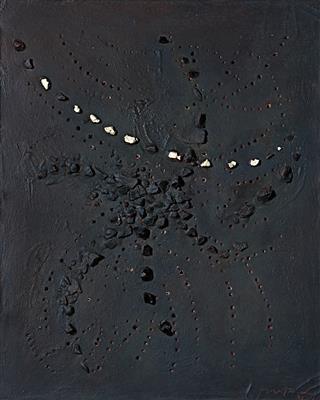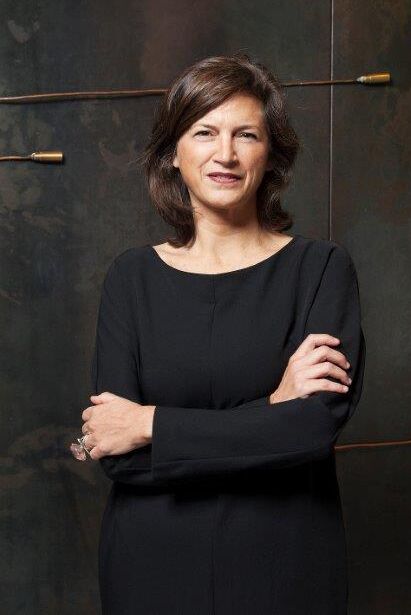Lucio Fontana *

(Rosario di Santa Fe, Argentina 1899–1968 Comabbio)
Concetto spaziale, 1955, signed, dated L. Fontana ‘55, on the reverse titled, signed, dated, perforations, stones and black waterpaint on canvas, 50 x 40 cm, framed, (PP)
The work has been registered by the Archivio Lucio Fontana under the archive no. 3828/1.
Provenance:
Private Collection, Italy – purchased from the artist in 1960
Formerly part of a prestigious private collection in central Italy, this hitherto unpublished gem from Lucio Fontana’s artistic output belongs to the short yet intense pictorial cycle known as “Pietre” (“stones”). In his imposing work about the artist, Enrico Crispolti describes this period thus: “ In 1952, and above all in 1953, Fontana not only pierces the canvas and adds colour, but also applies large glass fragments that enhance the work’s dimensional complexity, protruding from the surface in a kind of counterpoint with the holes, opening up new fantastic possibilities for the interplay of light and colours. Initially, he applied stones on monochrome canvas that are pierced according to a pattern of organised rhythmic motifs (...) that would lead him, in 1954 and 1955, to a grand style in the orchestration of these “stones” in constellations enriched by “taches”, where the “holes” are replaced by stones (...) Sometimes, the result of this reshuffling of matter from which stones emerge displays nigh “baroque” nuances (...). At other times, a balance becomes visible that is based on the counterpoint of holes and stones, in works stretched over large surfaces and yet rather severe. (...) These are the novelties characterising Fontana’s artistic evolution at the VII Quadriennale in Rome at the close of 1955. Although Fontana often resorted to the application of “stones” also in the 1960s, the aforementioned period certainly constitutes the triumphant moment in his use of this technique that represents an important aspect of Fontana’s artificial ‘materiologism’. Coloured glass, just like silver purpurin before, make explicit and maximise the artificial nature of Fontana’s creative intervention in his most intimate intention. Contemporary man is torn between a matrix of clay and mud, representing the time of his origin, and a reality of artificial creationalism exalted by the era of technology. Echoes are present of Klimt’s chromatic charms, his inventions in gold and silver, of Balla’s artificial matters, of the Futurist Severini’s famous “sequins” (and perhaps also echoes of the splendours of classical mosaics); but here is a vision of the world in all its extreme artificiality that is already yielding to its ultimate dissolution....
(Enrico Crispolti, Catalogo generale Lucio Fontana, Electa, 1986)
“The Spatialist artist no longer imposes a figurative subject upon the viewer, rather, it puts the viewer in a position to create it by himself, by means of his imagination and the emotions he receives”
(Lucio Fontana, Proposal for a Regulation of the Spatialist Movement, Milan 1950)
article Lucio Fontana - new baroque
Expert: Mag. Patricia Pálffy
 Mag. Patricia Pálffy
Mag. Patricia Pálffy
+43-1-515 60-386
patricia.palffy@dorotheum.at
20.05.2014 - 19:00
- Dosažená cena: **
-
EUR 653.800,-
- Odhadní cena:
-
EUR 550.000,- do EUR 750.000,-
Lucio Fontana *
(Rosario di Santa Fe, Argentina 1899–1968 Comabbio)
Concetto spaziale, 1955, signed, dated L. Fontana ‘55, on the reverse titled, signed, dated, perforations, stones and black waterpaint on canvas, 50 x 40 cm, framed, (PP)
The work has been registered by the Archivio Lucio Fontana under the archive no. 3828/1.
Provenance:
Private Collection, Italy – purchased from the artist in 1960
Formerly part of a prestigious private collection in central Italy, this hitherto unpublished gem from Lucio Fontana’s artistic output belongs to the short yet intense pictorial cycle known as “Pietre” (“stones”). In his imposing work about the artist, Enrico Crispolti describes this period thus: “ In 1952, and above all in 1953, Fontana not only pierces the canvas and adds colour, but also applies large glass fragments that enhance the work’s dimensional complexity, protruding from the surface in a kind of counterpoint with the holes, opening up new fantastic possibilities for the interplay of light and colours. Initially, he applied stones on monochrome canvas that are pierced according to a pattern of organised rhythmic motifs (...) that would lead him, in 1954 and 1955, to a grand style in the orchestration of these “stones” in constellations enriched by “taches”, where the “holes” are replaced by stones (...) Sometimes, the result of this reshuffling of matter from which stones emerge displays nigh “baroque” nuances (...). At other times, a balance becomes visible that is based on the counterpoint of holes and stones, in works stretched over large surfaces and yet rather severe. (...) These are the novelties characterising Fontana’s artistic evolution at the VII Quadriennale in Rome at the close of 1955. Although Fontana often resorted to the application of “stones” also in the 1960s, the aforementioned period certainly constitutes the triumphant moment in his use of this technique that represents an important aspect of Fontana’s artificial ‘materiologism’. Coloured glass, just like silver purpurin before, make explicit and maximise the artificial nature of Fontana’s creative intervention in his most intimate intention. Contemporary man is torn between a matrix of clay and mud, representing the time of his origin, and a reality of artificial creationalism exalted by the era of technology. Echoes are present of Klimt’s chromatic charms, his inventions in gold and silver, of Balla’s artificial matters, of the Futurist Severini’s famous “sequins” (and perhaps also echoes of the splendours of classical mosaics); but here is a vision of the world in all its extreme artificiality that is already yielding to its ultimate dissolution....
(Enrico Crispolti, Catalogo generale Lucio Fontana, Electa, 1986)
“The Spatialist artist no longer imposes a figurative subject upon the viewer, rather, it puts the viewer in a position to create it by himself, by means of his imagination and the emotions he receives”
(Lucio Fontana, Proposal for a Regulation of the Spatialist Movement, Milan 1950)
article Lucio Fontana - new baroque
Expert: Mag. Patricia Pálffy
 Mag. Patricia Pálffy
Mag. Patricia Pálffy
+43-1-515 60-386
patricia.palffy@dorotheum.at
|
Horká linka kupujících
Po-Pá: 10.00 - 17.00
kundendienst@dorotheum.at +43 1 515 60 200 |
| Aukce: | Sou?asné um?ní |
| Typ aukce: | Salónní aukce |
| Datum: | 20.05.2014 - 19:00 |
| Místo konání aukce: | Wien | Palais Dorotheum |
| Prohlídka: | 10.05. - 20.05.2014 |
** Kupní cena vč. poplatku kupujícího a DPH
Není již možné podávat příkazy ke koupi přes internet. Aukce se právě připravuje resp. byla již uskutečněna.
